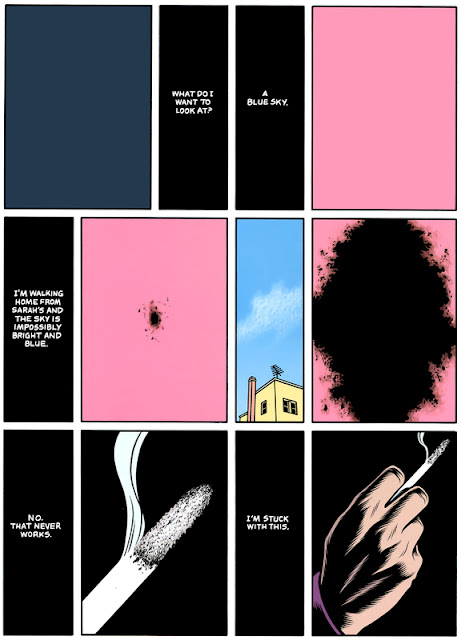X'ed Out was perhaps the most unsettling comic book to come out in 2010 that I've read. The first major work of Charles Burns since his critically lauded Black Hole in 2004, the two share common themes and ticks: an exploration of the sense of alienation and disconnect felt by adolescents, a fascination with body horror, and a stream of conscious style of writing used to convey the inner turmoil of his protagonists. This last characteristic is enlarged upon in X'ed Out as the book continuously shifts back and forth between several settings in a nonlinear, seemingly random, order. All of them focus on the experiences of a young man named Doug. The book presents the reader a neurological jumble of memories, thoughts, and feelings. Doug himself is as much bewildered by them as the reader is when attempting to tie together the threads of his tattered life.
Because the story is seen from Doug's own point of view, it's an extremely claustrophobic experience. Doug is a person trapped inside his own head, and the reader is offered no relief in the form of another character's perspective. There's a younger teenage Doug, and a somewhat older bedridden Doug who regularly takes unspecified pills, and becomes easily upset over the smallest disturbance. It's not clear how the two characters are connected. Between them, there's another Doug who inhabits a bizarre nightmare world were he looks like a poor man's version of Hergé's famous boy hero Tintin. Is this a dream, an idle fantasy, or an alternate reality? Like his bedridden self, this Doug wears a purple bathrobe and has one side of his head shaved and bandaged for unexplained reasons. It's a freakish puzzle that will leave the reader either very frustrated or highly stimulated. Or a maybe a little of both.
The page layouts follow a traditional grid pattern to lend the story some visual certainty. But otherwise, X'ed Out uses a more unconventional, polyphonic, labyrinth, narrative structure. Burns doesn't bother with establishing shots to demarcate his scenes. Rather, each flows unexpectedly into one another. The book is rich in motifs, both visual and verbal, to help clue the reader in: Snatches of repeated phrases, photographs, repetitious views, symbolic imagery, and fields of pure color. The presence of color makes it a very different work from Black Hole. It wields it as a tool to transition between scenes and as a way to add a further layer of meaning. The color palette hews to the Tintin books preference for flat, bright, pastel quality, local colors. And while Hergé and Burns have contrasting drawing styles, the coloring works equally well, but for different reasons. Within the nightmare world, Doug is like Tintin the globe-trotting explorer of exotic locals. But whereas Hergé's ligne claire exhibits a similarly bright world of clear-cut moral distinctions, in Burn's case the color serves to highlight the grotesque imagery delineated by Burns bolder strokes and murky black areas. It's a beautifully clever subversion of Hergé's world view. What emerges is more primal and terrifying.
X'ed Out doesn't cast the reader entirely adrift. Doug's most vivid memories center around an enigmatic love interest named Sarah. Burns also provides an anchor for the story in the flashbacks to Doug's younger self: they reveal that he was a involved in the punk rock scene as a performer of spoken word pieces, he called himself Nitnit (An inversion of Tintin), and he wore a Tintin mask during his performances. They paint a more complete portrait of Doug's and Sarah's personalities, and are the most straightforward parts in the book. Because of the information they supply, a number of disturbing possibilities begin to emerge on how the various timelines will converge in the end. In particular, the front and back cover illustrations, a shout out to The Shooting Star, become downright creepy in it's implications after reading the last page.
This book is only the opening chapter of a larger work. Like Black Hole, Burns has chosen to serialize his story before releasing a collected edition. But whereas the earlier work was first published in pamphlet form, X'ed Out utilizes the larger album format. It's a good choice, as it feels more substantial and exhibits more of Burns talents to entice the reader into the story (not to mention that this is also another way to relate it to Tintin). With this in mind, X'ed Out will require several re-readings, especially after the final installment is published.





